Introduction
Crafting a Proof of Concept (POC) document is a crucial step in validating the feasibility of an IT solution. It involves meticulous research, planning, and testing to ensure accurate assessment and effective communication. A well-executed POC serves as a navigational chart, guiding businesses through uncharted technological waters and transforming abstract ideas into tangible prototypes.
In this article, we will explore the importance of a POC document, its role in mitigating risks and increasing cost-efficiency, and the step-by-step process of creating a sample POC document. We will delve into defining the project scope and objectives, identifying the target audience, gathering necessary information and resources, and developing a detailed plan and timeline. Additionally, we will discuss the creation of a prototype or proof of concept, testing and validating the POC, documenting findings and recommendations, and presenting the POC document.
By following best practices and avoiding common mistakes, businesses can harness the transformative power of a well-crafted POC document. This comprehensive guide provides industry insights and expert advice to help organizations navigate the challenging terrain of IT projects and achieve strategic alignment and project success.
What is a Proof of Concept (POC) Document?
Crafting a Proof of Concept (POC) in the realm of business IT is analogous to conducting a crucial experiment to validate a theory. This experiment, the POC, scrutinizes the anticipated benefits and possible pitfalls of deploying novel IT solutions. It meticulously maps out the goals and anticipated impact in a coherent document, akin to a navigational chart guiding a ship through uncharted waters.
Such documents are not only essential for capturing the theoretical advantages but also for bringing stakeholders into alignment, ensuring clarity in the project's direction. A thoroughly conceptualized POC can differentiate between an educated guess and an evidence-backed decision, framing the adoption of technology not as a gamble but as a strategic move towards innovation.
Why is a POC Document Important?
Ensuring the development of a successful Proof of Concept (POC) for new IT solutions necessitates careful documentation. Such a document underpins the project by offering a preliminary evaluation of its overall feasibility and potential return on investment. A prime example of prudent feasibility assessment in action was demonstrated by the Ford Foundation's initiative in updating their digital engagement platform.
Bedirhan Cinar, Head of Product and Digital Engagement, underscored the evolutionary requirements of their audience and organization, which led to the creation of a new video accessibility plugin for the WordPress community.
Accessible documents are a cornerstone of effective POCs, as emphasized by Alex Weishaupl, Managing Director at Protiviti Digital. Designing with inclusivity in mind, whether through semantic HTML or consistent document layout, ensures that all stakeholders can understand and interpret the POC findings accurately.
The relevance of a POC is further illustrated by large-scale studies like the CHAOS Report, which regularly gauges the status of software projects globally. Its classification of projects into 'successful', 'challenged', and 'failed' categories offers stark statistics: about 30% succeed, 20% fail, and a staggering 50% face challenges. A well-crafted POC—emphasizing technical feasibility over business value—can play a pivotal role in steering a project toward that coveted 'successful' category by addressing project viability right from the outset.
In a rapidly advancing digital landscape, the stakes for IT-related projects are high, and the foundational processes are still maturing. Incorporating a rigorously tested POC mitigates the considerable risks associated with new technology adoption. It does so by offering a realistic lens through which the technical soundness and potential integration challenges associated with new IT solutions are scrutinized.
Far from being a mere formality, the creation and evaluation of a POC, underscored by meticulous documentation, serve as the critical backbone to achieving strategic alignment and project success.
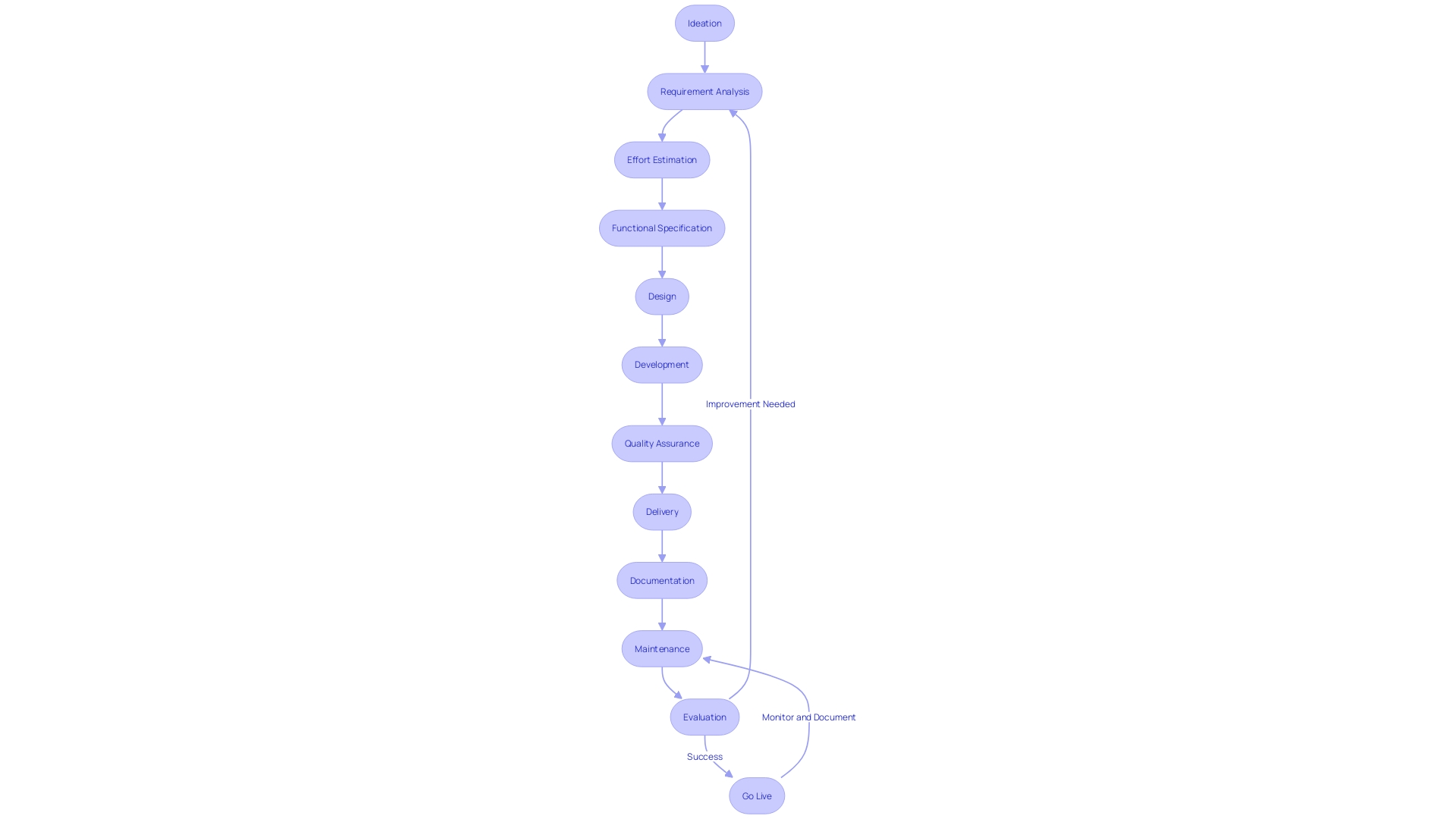
Step-by-Step Guide to Creating a Sample POC Document
The journey to crafting a proof of concept (POC) document is akin to preparing a blueprint that meticulously outlines the specifics of a project. The steps involved are central to ensuring the project's viability and effectiveness. Commence by delving into the intricacies of the current market challenges and exploring the demographic inclined towards organic produce.
This endeavor must be backed by astute market research to discern consumer preferences.
Subsequently, articulate the user requirements with precision, emphasizing key factors such as freshness, selection range, and the assurance of organic certification. The application's architecture should encompass fundamental functionalities, including a comprehensive product catalogue, robust search and filtration options, dependable delivery services, and varied payment integrations.
In augmenting the application's usability, it is imperative to focus on user experience (UX) and user interface (UI) design considerations, ensuring the platform's ease of use and accessibility remains uncompromised. The technical blueprint should detail the requisite technology stack needed to actualize such an application, including frontend frameworks, backend technologies, and database solutions.
To crystalize the POC, define what project success looks like and the enhancements anticipated upon resolving the identified issues. Aid this definition with evidence-supported arguments—data, statistics, case studies, and real-world accounts—to substantiate the problem's scale and its ripple effects.
Moreover, avoid common pitfalls in document creation by maintaining clarity and simplicity in communication. Adjust your linguistic approach to cater to diverse audiences, ensuring the documentation is understandable without sacrificing technical specificity. These facets together construct a strong POC that not only resonates with its intended audience but also forms a solid foundation for the project's subsequent phases.
Define the Project Scope and Objectives
A Proof of Concept (PoC) is more than just an experimental project; it's a strategic evaluation to validate the feasibility of your product's core concepts. By utilizing Pics, we can illustrate that the technological solution we're proposing is not only theoretically possible but also practically viable. Through thoughtfully crafted use cases, the PoC document becomes a narrative, mapping out the intended functionality of the product and the desired outcomes, which Dropbox has famously demonstrated in its early stages.
It is essential to not only identify what the system is to do, as prescribed by the Unified Modeling Language (UML), but also to elucidate how it will navigate through various scenarios, including alternative paths to success.
When defining the project scope, it is crucial to articulate clear objectives, deliverables, and anticipated results. This aids in establishing tangible expectations, aligning the PoC with the project's specific requirements. It's about conveying the 'what' and the 'when' of product functionalities and releases, breaking down the requirements into operational, functional, or design specifications.
Such definitions serve as a benchmark for measurability and testability, ensuring that the final product reflects the solution to the issue at hand, rather than becoming an impressive, yet ultimately non-functional, display of data acumen.
The strategic importance of a PoC is underscored by its capacity to mitigate risk and increase cost efficiency. In a world where smart home automation and the Internet of Things (IoT) are booming industries, understanding the intricacies and potential challenges before a full-scale roll-out is imperative. As the projected market value reaches staggering heights, the PoC becomes the testing ground for innovative, unprecedented solutions, much like those envisaged by visionary IT departments committed to creating what has yet to be imagined.
Thus, a well-defined PoC is instrumental in navigating us from the realms of possibility to the realities of technological advancement and market readiness.
Identify the Target Audience
When initiating a Proof of Concept (PoC), it's vital to clearly identify who will review and evaluate the document. This generally includes key stakeholders and decision-makers within your organization, as well as project managers and technical leads entrusted with the implementation of the project. Central to the success of a PoC is the alignment of its objectives with the strategic vision of these key figures, thus ensuring that the proposed solution not only demonstrates its feasibility but also its potential to contribute effectively to the business's overarching goals.
Through in-depth research and analytics tools such as Google Analytics and Facebook Audience Insights, you can gain an accurate understanding of these individuals’ needs, including their typical challenges, decision-making processes, and criteria for project approval. It's also important to consider the demographics, behavior, and responses of the teams that will be directly involved with the PoC, as their support and involvement are essential for a successful pilot. By doing so, the PoC documentation can be tailored to speak directly to these audiences, addressing their specific concerns, and effectively communicating the benefits and potential of the proposed IT innovation.
According to recent software development trends, the IT sector is rapidly evolving with a significant surge in roles such as developers, designers, analysts, and engineers. With over 13.4 million professional developers worldwide as of 2023, it's clear that technical projects require a depth of understanding and precise communication to meet the expectations of a diverse, informed group of stakeholders. Incorporating findings from this evolving landscape can further enhance the PoC by ensuring that the content resonates with an audience that is well-versed in the latest technological advancements and market trends.
Gather Necessary Information and Resources
To craft a compelling and authoritative Proof of Concept (POC) document, it's crucial to gather comprehensive and precise information that reflects market trends, technical potential, and financial feasibility. This involves leveraging thorough market research to tap into current user demands and future projections, akin to how wildfire risks have been meticulously studied to understand their sources and mitigation measures in the California case study, involving 65 hours of rich investigation.
Outlining technical specifications becomes the blueprint of POC, much like the standards used to gauge electrical company conduct in investor-owned utilities. Also, a detailed financial analysis not only highlights the economic viability of the project but echoes the need for a clear understanding of the costs of the undertaking, mirroring the careful dissection of mitigation strategy expenses in the wildfire prevention field.
To echo the sentiment of informed considerations, documentation should be user-centric, taking into account the perspective of the end-user and their context, ensuring accessibility and clarity for all potential readers. This approach mirrors the successful tactics of creating open data platforms in STEM, ensuring that data curation caters seamlessly to researchers, policymakers, and decision-makers.
Furthermore, the integration of various sources and types of information into the POC document ensures a holistic and robust presentation. This mirrors the innovative architecture of the Open Data ELLAS Platform that streamlines data from its raw state to the end-user consumption, emphasizing the value of consolidating information into a single, reliable source. Thus, a well-crafted POC should mirror these multi-layered approaches to data handling and presentation, designed to serve a diverse audience effectively.
Develop a Detailed Plan and Timeline
When establishing a Proof of Concept (POC), crafting a comprehensive strategy and timeline is essential. This detailed plan must encapsulate all critical phases of the small-scale project, highlighting pivotal milestones, assigned tasks, and stringent deadlines. By creating such a structured plan, organizations can manage expectations effectively and facilitate the execution of the POC process with efficiency and precision.
By engaging in a POC, teams delve into new technologies, assessing their capabilities and gaining valuable insights—a practice exemplified during the rapid growth of the smart home automation market and in innovative fields like computer vision. These projects illuminate the potential of emerging technologies and pave the way for further innovation and technological adoptions. A tailormade, clear-cut plan for a POC provides not just a pathway to testing the feasibility of an idea but also gives a chance to align IT strategies with broader business objectives, addressing the key question: 'Can it be done?'
Moreover, it ensures that the objectives are strategically aligned with the broader technology adoption roadmap, fitting snugly within the organization's enterprise architecture. This alignment is fundamental to recognizing and overcoming challenges, as evidenced by the iterative and inclusive discovery phase crucial to machine learning projects. Focusing on essential technical elements of a POC allows organizations to sidestep distractions, maintain a clear direction, and ultimately position themselves better in an evolving digital environment.
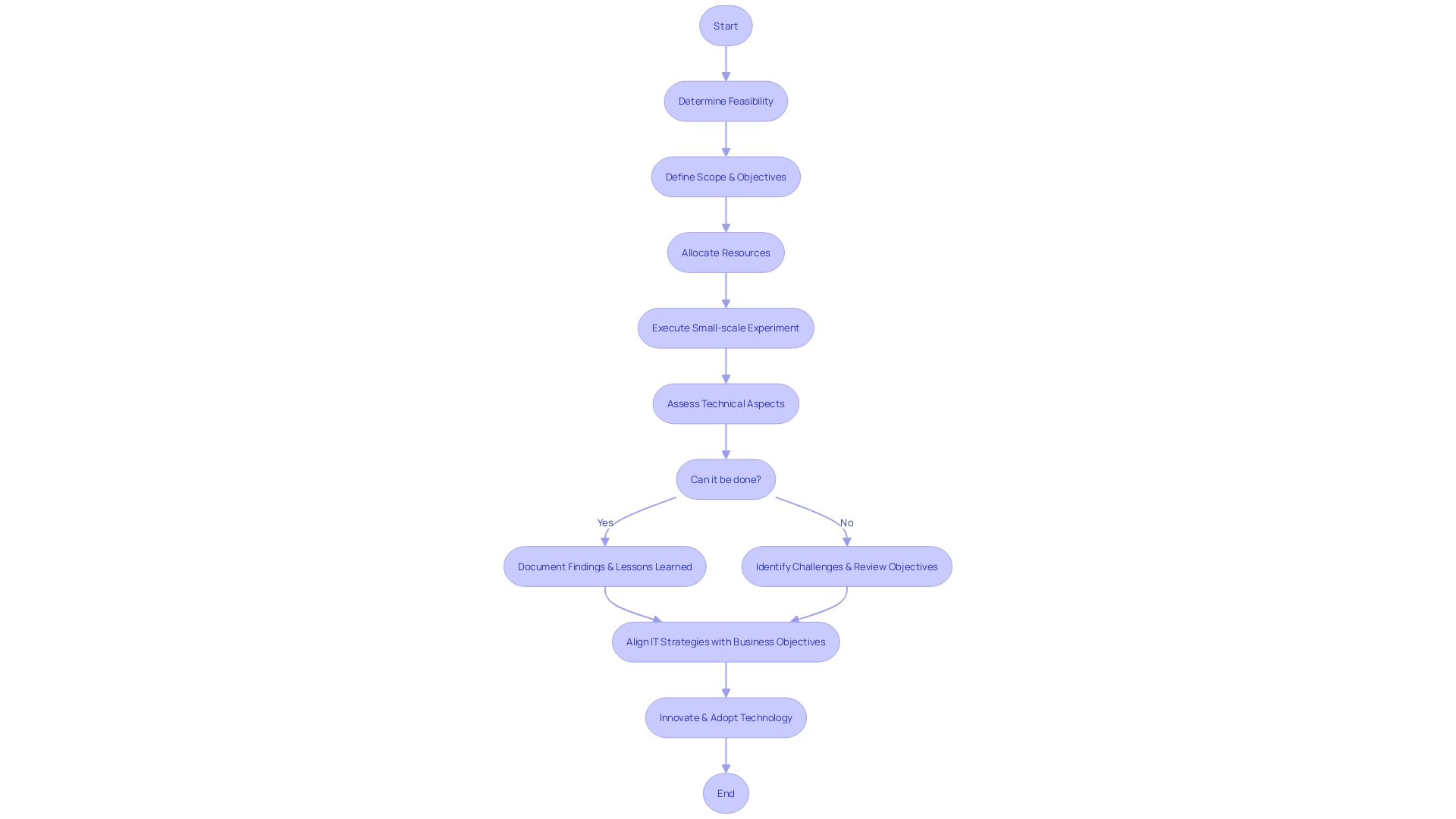
Create a Prototype or Proof of Concept
Creating a prototype or Proof of Concept (PoC) plays a critical role in the development of any IT project. It's the foundational step where an idea transforms into a preliminary version, showcasing the functionality and demonstrating viability. Companies like Nets have leveraged this approach to present technical data in engaging, accessible formats, thus simplifying complex concepts for stakeholders.
Similarly, eye has utilized Pics to revolutionize their onboarding process amplifying both engagement and results.
While a PoC is a condensed and often innovative presentation of an idea's potential, a prototype is a more tangible and developed representation of the concept. A prototype goes beyond mere feasibility; it explores user interaction, design, and functionality on a more intricate level, akin to the robustness that Coffee IT exemplified in their client solutions.
These steps not only confirm the practicality of concepts but also mitigate risks, enhance cost efficiency, and lay out a road map for future development stages. The success of Dropbox’s launch, built on a sturdy PoC, exemplifies how these early demonstrations can garner user feedback and investor confidence, serving as a bedrock for the billion-dollar enterprise it is today.
Moreover, with a projected surge in smart home automation reaching a market value of $40 billion by 2020, PoCs in IoT projects underline the growing importance of validating the interconnectedness and functionality in a dynamically evolving digital landscape. This methodical approach to IT development underlines the transformative power PoCs have in converting abstract ideas into real-world solutions that meet market demands while keeping pace with technological advancements.
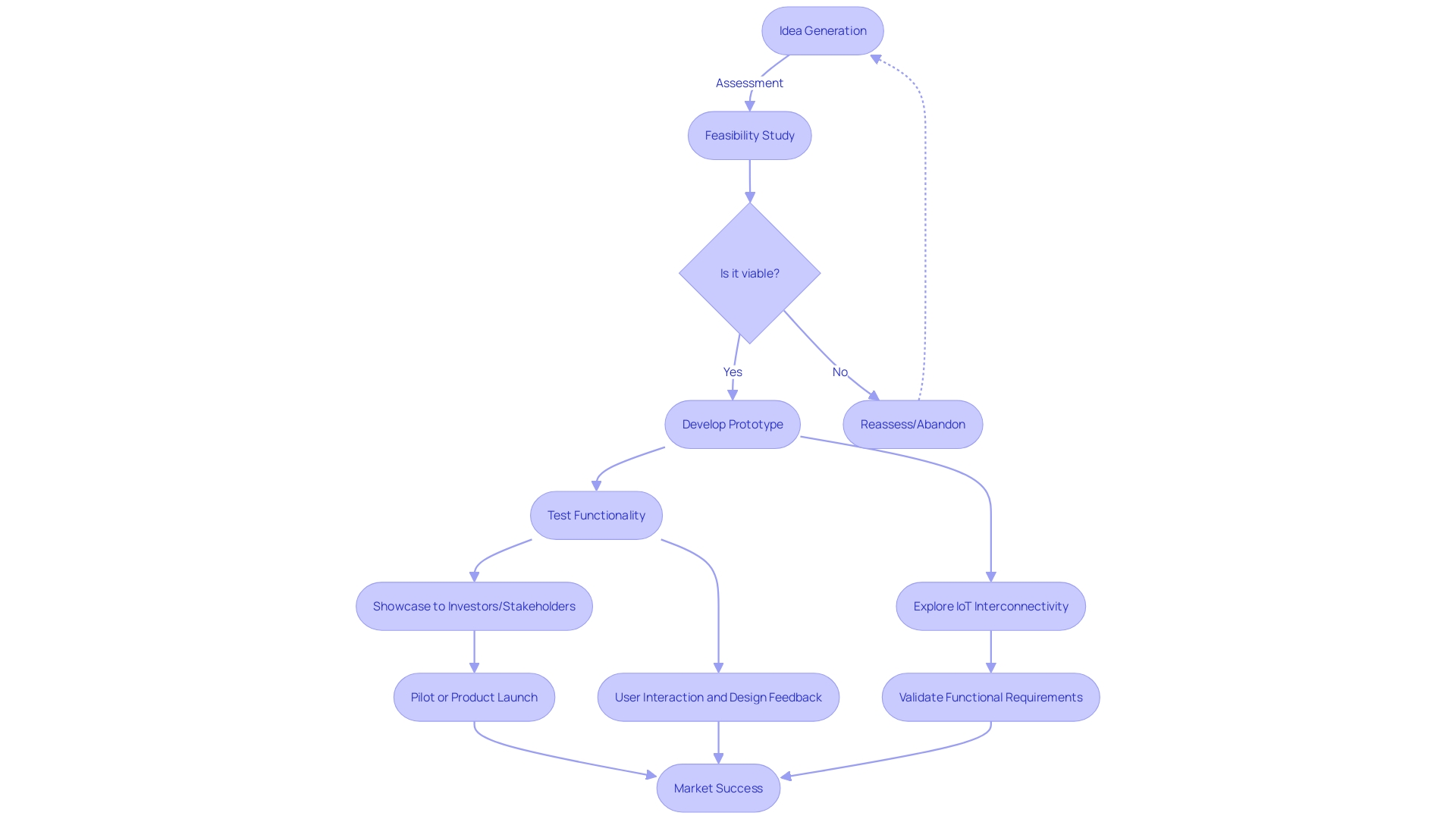
Test and Validate the POC
Rigorous testing and validation form the cornerstone of a successful Proof of Concept (POC). It's crucial not only to examine whether your POC aligns with intended goals and performs up to standards, but also to seek meaningful feedback through various simulations and user engagement. This process is enlightening, often uncovering room for enhancement before taking the leap into full-fledged implementation.
To illustrate, consider the development of domain-specific tools, such as the differential and merging utilities for popular relational databases initially fine-tuned for internal use at Access. Their functionality was honed through testing relevant scenarios—without entangling in the nitty-gritty of coding works. Such focused evaluations are paramount to ensure that when the product faces real-world demands, it excels in performance and utility.
Echoing this sentiment, Ilana Arbisser, Technical Lead for AI Safety at Snap Inc., sheds light on a proactive safety validation approach. Before introducing Snap's trailblazing text-to-image AI product, the team undertook an 'AI red-teaming' to intercept any unsuitable content from reaching the community. By envisaging and countering these risks in advance, the POC not only validates functionalities but also fortifies the product's stand on ethics and user protection.
Additionally, consumer-driven contract testing, where software components are verified against agreed specifications, exemplifies the importance of meticulous POC validations. It clarifies expectations between services and ensures the new application collaborates faultlessly with existing systems, much like ensuring the integrity of a new feature within an established inventory system.
By integrating divergent perspectives garnered from interviews with over a hundred professionals, the CDC and USDS illustrate how iterative creation and feedback loops can revolutionize POCs, culminating in tools that are not just functional but demonstrably beneficial to end-users.
Altogether, a well-executed POC validated through thorough testing and real-world feedback is an investment in confidence. It's a shield against the risks of embracing new technologies and a beacon directing businesses toward cost-efficient and strategically sound digital transformations.
Document Findings and Recommendations
Upon concluding a Proof of Concept (PoC), it is crucial to synthesize and articulate the findings thoroughly. The process not only reveals areas of strength that the solution brings but also uncovers any weaknesses or threats that need to be addressed before broader application. These insights are critical and serve as a compass for the subsequent steps.
The documentation should encapsulate how the technology or solution meets user requirements—established through meticulous practices like use case development—a methodology advocated by Alistair Cockburn since 2000 in 'Writing Effective Use Cases.' It's paramount to discern whether the solution directly tackles the problem at hand, as underscored in the CHAOS Report, which indicates only 30% of IT projects are fully successful. Based on the PoC’s outcomes, clear-cut guidance on proceeding with full-scale deployment or necessary tweaks should be provided, ensuring the decision aligns with the organization's strategic objectives and mitigates risks of adopting nascent technologies.
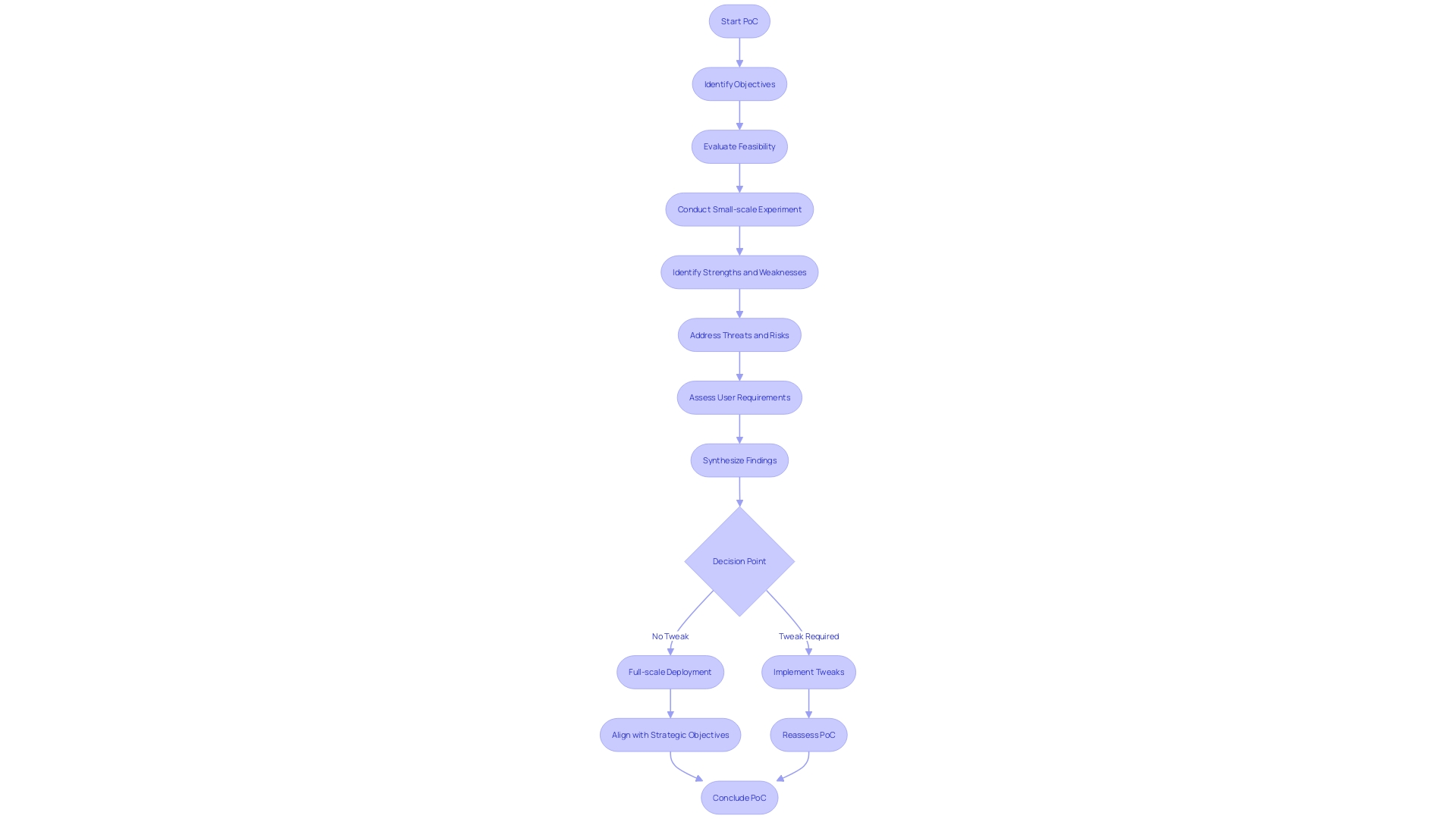
Present the POC Document
When designing the Proof of Concept (POC) presentation, it's essential to eloquently demonstrate both the execution and evolution qualities of your IT system. These may include, but aren't limited to, safety, security, usability (observed during operation), and qualities like testability, maintainability, extensibility, and scalability (found in the system's static structure). Expounding on these qualities ensures stakeholders comprehend the full spectrum of your system's capabilities.
Utilize bar graphs and line charts effectively; these visual tools are not just decorative elements but fundamental in conveying complex information intuitively. Bar charts excellently compare data across different categories or illustrate trends over time. Their straightforward format, with categories on the x-axis and values on the y-axis, facilitates easy digestion of raw data.
On the other hand, use line charts to trace trends and variations over time, particularly if your POC data includes time-phased elements like sales projections or demand fluctuations.
In creating your presentation, embed the principles of accessibility. By employing semantic HTML, ensuring captions and alt text for media, and crafting a consistent structure across all documents, you're not just complying with WCAG Success Criteria but also making your content more inclusive.
Remember, a POC document is much like a story, needing a narrative that addresses the audience’s day, distractions, and priorities, while providing them with the answers they seek. As George Lawton, an expert with three decades of experience, stated, personalization is key in any strategy. Reflect this ideology by considering how your POC findings resonate with the unique needs and objectives of your stakeholders, akin to how educators like Weishaupl integrate diversity and context relevance into academic projects.
Ultimately, the POC presentation mustn't be a mere display of technical prowess but a strategic communication that considers who you're addressing, the message you intend to convey, and the outcomes you aim to achieve.
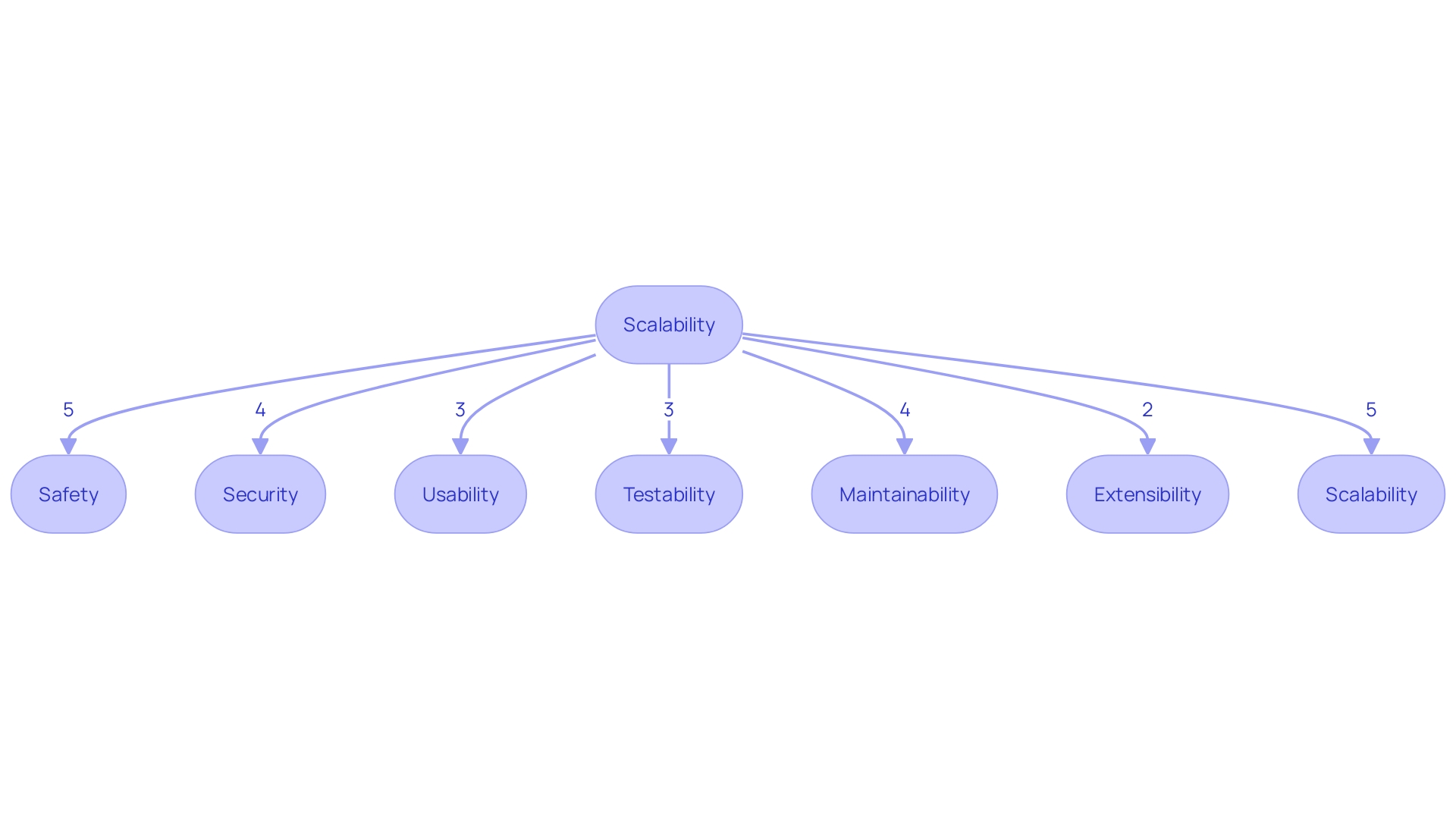
Best Practices for Creating an Effective POC Document
Building an effective Proof of Concept (PoC) is a critical step in the lifecycle of business IT projects, where ideas are transformed into tangible prototypes. When crafting a PoC document, it’s imperative to set clear project objectives and a concise scope. Involve stakeholders and domain experts early to benefit from diverse insights, and perform a thorough research to obtain accurate data.
A structured plan with unambiguous milestones is the backbone of a PoC. Develop a prototype that embodies the proposed solution, paying special attention to non-functional requirements such as usability and security, which are as vital as functional specs. Testing of the PoC should be robust, simulating real-world usage to uncover any potential issues, a strategy that Agile methodologies have turned mainstream by encouraging rapid iterations even in the late stages of development.
The documentation of findings should not just be comprehensive but also actively actionable. Use straightforward language to foster clarity, ensuring the content is grasped by all, regardless of their technical prowess or familiarity with the subject matter. Centroplan's successful implementation of document automation, leveraging their rich history of experience, exemplifies the efficiency gains a well-executed PoC can deliver.
A living document that evolves with the project is crucial. Just as the nature of software development has shifted towards flexible and iterative approaches, so too should the PoC documentation adapt to the changing landscapes and findings as experiments progress.
Lastly, present your document with impact, drawing upon principles of digital accessibility such as color contrasts and text spacing to ensure it is decipherable by the widest possible audience. This embodies the ethos of Agile's ‘sprints’, which value the adaptability of software and documents alike, aiming for continuous improvement to benefit both consumer engagement and internal productivity.
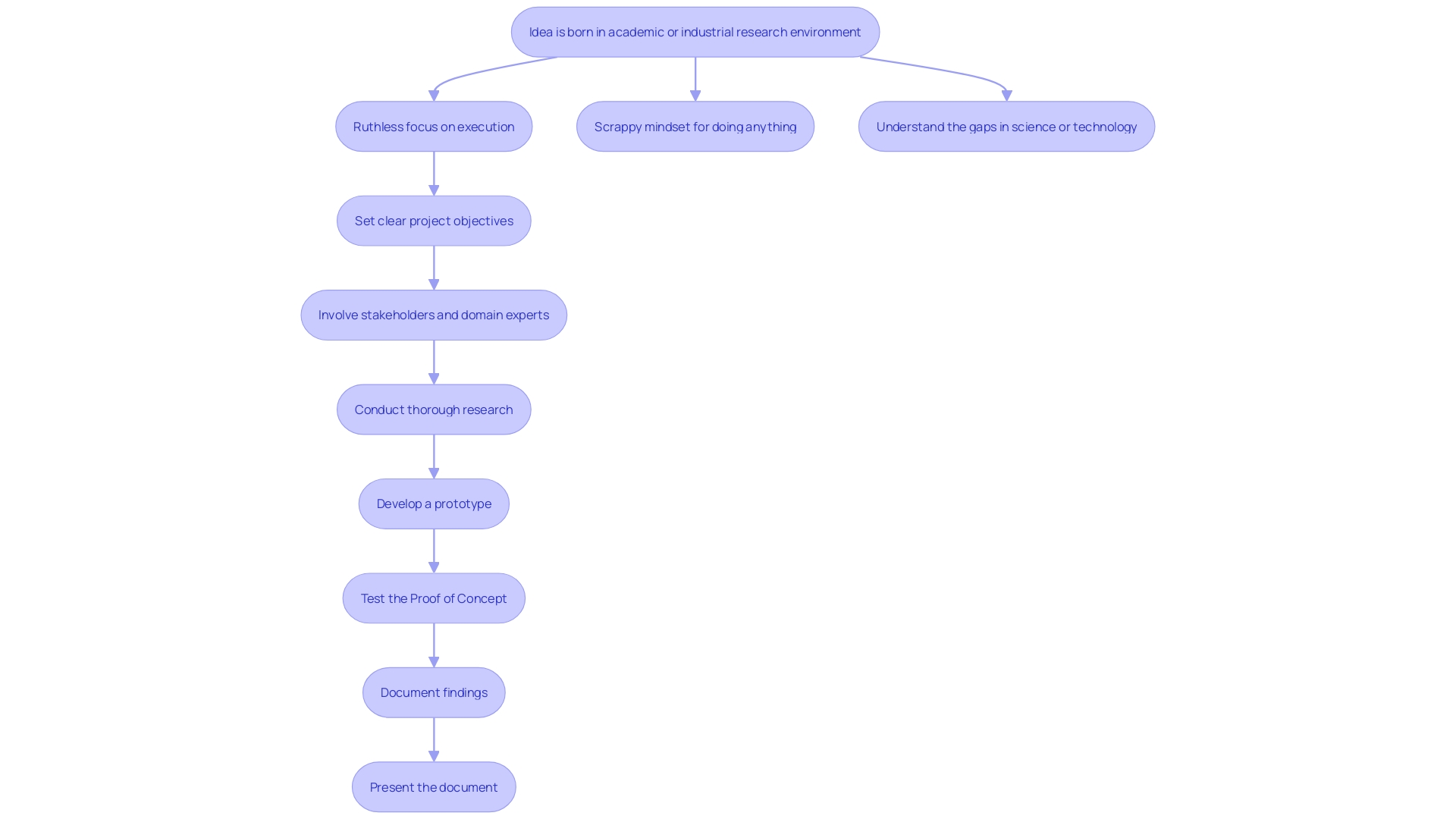
Common Mistakes to Avoid
Crafting a Proof of Concept (POC) document is a critical step in validating the feasibility of an IT solution, and avoiding common pitfalls can save time and resources. A well-constructed POC document should begin with definite objectives and scope, providing clarity and direction for the project. It's key to compile substantial research and data, as this serves as the foundation for validating your proposed solution.
Be cautious not to overcomplicate the POC; it should be succinct to keep stakeholders engaged.
When presenting, ensure the communication is crisp and professional; this reflects the quality of work behind the POC. It's also imperative to engage key stakeholders and subject matter experts early in the process. Their insights can be invaluable, and their buy-in is crucial for the progression of the project.
During the testing phase, rigorously validate the POC to iron out potential issues, and remember to continually refine your document in alignment with ongoing feedback and developments.
Remember, POC documents are often reviewed multiple times; hence, upfront quality in writing and presentation pays dividends in the long run. Additionally, consider including examples such as SQL queries or chatbot interaction flows to showcase system qualities like safety, security, usability, testability, and scalability. These examples can serve as concrete evidence of your POC's capabilities and how it addresses specific execution and evolution qualities essential for system operation.
In light of these considerations, ensure your POC document is a dynamic tool that evolves with your project, helping you navigate toward a successful IT implementation.
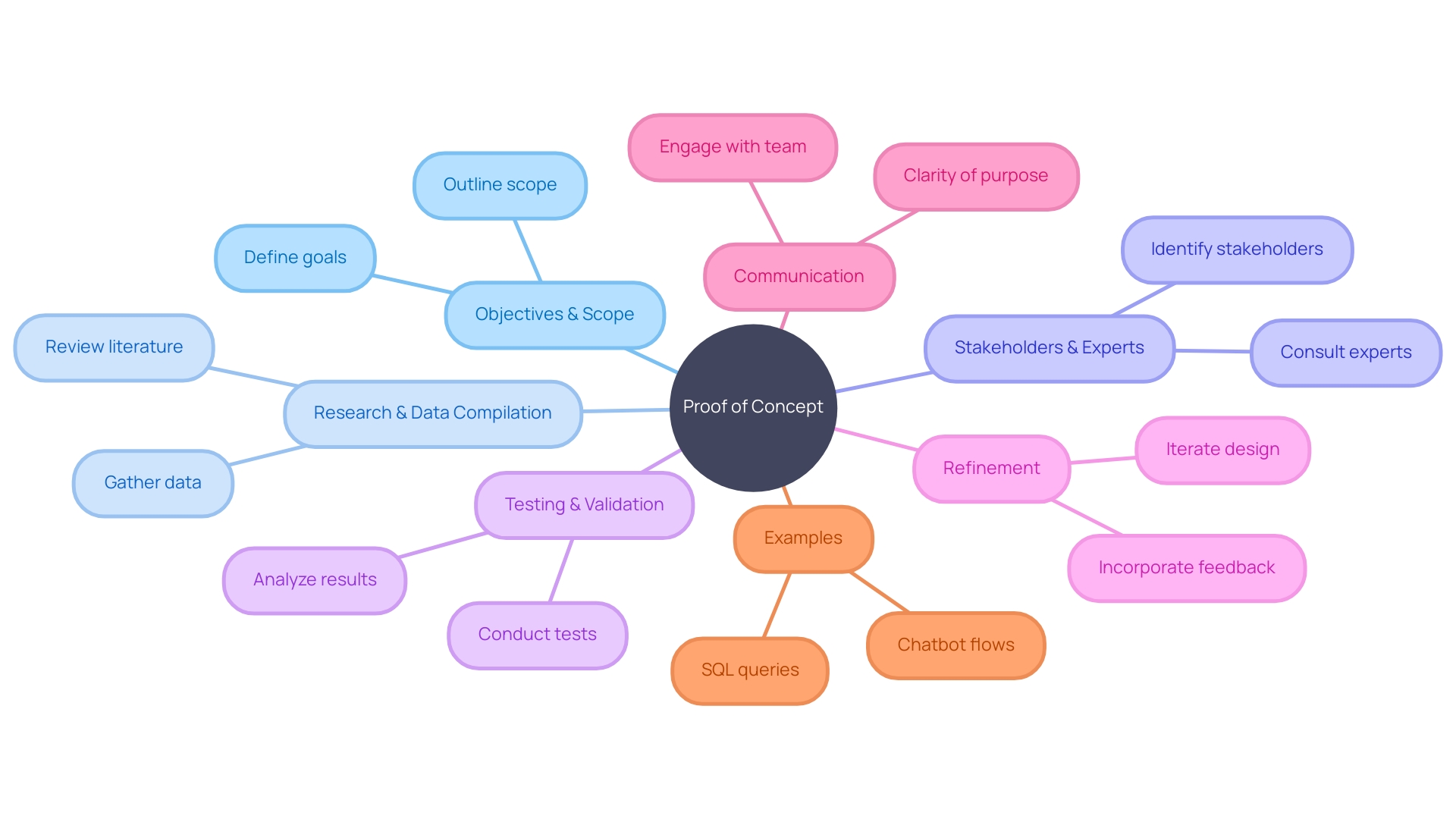
Conclusion
In conclusion, a well-executed POC document is crucial for validating the feasibility of an IT solution. It serves as a navigational chart, guiding businesses through technological waters and transforming abstract ideas into tangible prototypes. By following best practices and avoiding common mistakes, organizations can harness the transformative power of a well-crafted POC document.
A POC document mitigates risks and increases cost-efficiency. It offers a preliminary evaluation of the project's feasibility and potential return on investment. Incorporating a rigorously tested POC provides a realistic lens to scrutinize technical soundness and integration challenges.
The step-by-step process of creating a sample POC document includes defining project scope and objectives, identifying the target audience, gathering necessary information and resources, developing a detailed plan and timeline, creating a prototype, testing and validating the POC, documenting findings and recommendations, and presenting the POC document. Each step ensures project success and strategic alignment.
To create an effective POC document, set clear objectives, involve stakeholders early, perform thorough research, and develop a structured plan. The document should be comprehensive, actionable, and easily understood. Continuous improvement and adaptation are key, as the document should evolve with the project.
Avoiding common mistakes such as overcomplicating the POC, ensuring crisp communication, engaging key stakeholders, rigorously validating the POC, and refining the document based on feedback lead to successful implementation.
In summary, a well-crafted POC document validates IT solutions, mitigates risks, and ensures strategic alignment. By following best practices and avoiding common mistakes, organizations achieve project success in the challenging terrain of IT projects.





